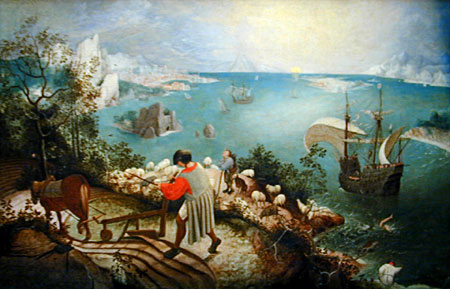Metamorphoses 8.183-235

This sixteenth-century painting by Pieter Brueghel the Elder is entitled "Landscape with the Fall of Icarus." Can you find Icarus? (hint: see this detail) Why do you think Brueghel gave the painting this title? How do the people in the painting react to Icarus? Here are some questions about Ovid's version of this story:
- Describe the situation of Daedalus. What does the expression ignotas animum dimittit in artes / naturamque novat mean (ll. 188-89) and why is this ability of Daedalus significant for the Metamorphoses (note that James Joyce used the first part of this quotation as the motto for his novel Portrait of the Artist as a Young Man, whose hero is named Stephen Dedalus)?
- Lines 195-200 introduce Icarus to the reader. What is he doing? What Latin words foreshadow the coming tragedy? This sixteenth-century German illustration tries to suggest the same foreshadowing in visual terms.
- What effects does Ovid create in lines 201-202 through the word placement and the use of the verb libravit and pependit? What philosophical teaching does Daedalus's warning to Icarus draw upon?
- What is the effect of oscula . . . non iterum repetenda (lines 211-212)? What simile does Ovid use to describe the "take-off" of father and son? Is this effective? Do you think that Pieter Brueghel might have had lines 217-20 in mind when he painted the picture above? Why or why not? Why does credidit esse deos add to the foreboding?
- What is striking about deseruitque ducem caelique cupidine tractus (line 224), and how does it recall Daedalus' original plan?
- Analyze the special effects achieved by word choice and word placement in Ovid's description of the fall of Icarus (lines 227-230). This was a favorite subject for artists; see this sixteenth-century German illustration and this painting by Annibale Carraci.
- How does Ovid convey the distress of Daedalus? How does the phrase Devovitque suas artes (line 234) return us to the beginning of the story in a kind of "ring composition"?